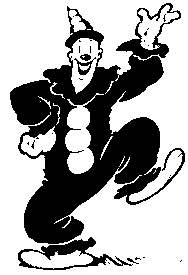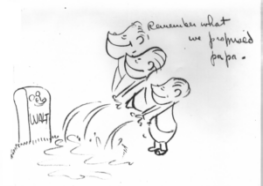
.

![]()
![]()
![]()
![]()
![]()
![]()
![]()
![]()
![]()
![]()
![]()
![]()
![]()
![]()
![]()
![]()
![]()
Contents
•
WARD KIMBALL's introduction at the 1978 Annie Awards (Anim.
P. 1)
•
GRIM NATWICK's Memoria (this
page)
•
DICK HUEMER's recollections about his career (Animation
Page
3)
•
JOE ADAMSON's interview concerning the Fleischers (Anim.
Page 4)
•
FILMOGRAPHY from Disney's (Animation Page 5)
•
OBITUARY from Daily Variety (Animation
Page 6)
DICK HUEMER 1898-1979: Homage to a Star by Grim Natwick
One day in February, 1930, Bill Turner telephoned me at my apartment in New York City. Bill, at that time, headed an embryo story group at the Max and Dave Fleischer Animation Studio. Bill said, "Grim, how would you like to get back into animation?" I had been away from animation for more than a year. The last cartoons I had worked on were for silent pictures. In November, 1928, the Colony Theatre in New York ran Walt Disney's STEAMBOAT WILLIE with sound. It was a sensation. It caused an explosion in the animation milieu. Animation became transformed from a giveaway bauble into legitimate theatre entertainment. It suddenly achieved social status. In a few years it would have top billing on the marquees of movie houses.
Well, before our phone talk ended, I had agreed to an interview. Next day I met Max Fleischer and he offered me a job. Bill Turner took me through the studio and I met some of the animators. We paused at an empty desk. Bill said, "This was Dick Huemer's desk; he left to take a job in Hollywood."
Dick's last drawing was still on his pegboard. There were two big lessons in that simple drawing; two things I would soon put into practice. The drawing showed two animation figures about four inches apart. A curved line extended from one figure to the other. This line was carefully spaced with short lines indicating that other drawings would fill the empty space between the two key figures. I had never animated to a sound track. This would be my first lesson. In little more than a year, animation had become a new profession. Now the art of drawing had locked arms with music. In another year it would embrace color with its unlimited possibilities. It was a new world. I said nothing to anyone about what I had learned -- I pretended that I had known it all of the time. Next week I would start animating at Fleischers'. Was I supposed to fill Dick Huemer's shoes? I could never do it; Dick was way ahead. I would have to learn animation all over again.
|
It is a hop, skip and a jump from Bill Turner's telephone call to the day in 1934 when I would meet Walt Disney for the first time. The animation wires were buzzing things about the Disney Studio starting a feature length animated car-toon. I, too, had left Fleischer's for Hollywood. In 1931 both Walt and Ub Iwerks had offered me jobs. Foolishly or not, I chose to work for Iwerks who had sold his one-third interest in the Disnev Studio to Walt and had started produc- ing pictures like FLIP THE FROG and WILLIE WHOPPER.
|
|
I had spent three pleasant years with Ub. An opportunity to work on the first animated feature intrigued me. Ted Sears, at that time, headed a Walt Disney story group. He was a good friend of mine. I asked Ted if he would intercede for me, pick a moment when Wait was in a good mood, and suggest that I would like to join the Disney staff. Two weeks later Ted telephoned and said, "Walt will meet you after work next Monday."
After work on Monday night, I drove over to Walt's Hyperion Studio, a new studio at that time. Walt met me very graciously and after a few casual remarks he decided to show me through the building. He seemed very proud of it. We stopped at one animator's room, Dick Huemer's room.
A drawing was on the pegboard, an exquisite drawing. It turned my blood to ice. I thought,'Holy Mackerel! Do I have to draw that well to hold a job here?" In my total life I had not seen a drawing like this in an animation studio. I tried not to let Wait know how I felt.
We continued our trip ending up at Walt's office. Walt had made up his mind; he decided to hire me. He said. "We'll start you at $150.00 a week; that's what Dick started at." Two weeks later I joined the staff of the Disney Studio. As I drove home after my visit with Walt I could only think of Dick Huemer's drawing. Fortunately my first assignment at Walt's Studio did not call for the superb drawing I had seen on Dick's desk.
What kind of man was Dick Huemer? He spent almost his entire lifetime in animation studios, working first with Raoul Barre on the Mutt and Jeff pictures. This was in 1916. Dick was eighteen years old. He became a key artist at the Fleischer Studio when they produced their famous OUT OF THE INKWELL pictures. In 1930 he moved to Hollywood with the Charley Mintz group and in 1933 he joined the Disney staff. This adds up to about sixty years spent with animated cartoons. The last forty years he worked at the Walt Disney Studio.
When, in the middle 1930's, animation stepped out of its baby shoes and into seven league boots, Dick decided that story and story direction was 'where the action was.' With Walt's agreement he left animation and joined the directorial segment of the studio. Dick was "hooked" on classical music, an uncommon addiction among animators. Because of this idiosyncrasy, Walt chose him, along with Joe Grant, to select musical scores for FANTASIA, a picture some thought too culturally attired for the cinema audience of 1940.
Dick and Joe put together the screen script for Dumbo, one of the happiest pictures on the Disney roster. Dick also directed animation on Dumbo, on Saludos Amigos and on Alice in Wonderland.
He was one of the artists who helped build the early framework of animation. He was a wise and witty man, a droll man who, in a quiet way, pulled rugs from under pompous and false heroes, transformed giants into pygmies and inauspiciously extracted the teeth from snarling paper lions. He was with animation through all its gowing pains. Whatever animation became, he helped to shape it, drawing by drawing, idea by idea.
Today no one questions the status of animation as an original art form. Its special quality demands that many talents are needed to produce it, but the separate talents are easy to name. Richard Martin Huemer shines brightly in that unusual galaxy.
Way, way up where the sky is at its bluest, where clouds are like tufts of cotton blown on an autumn wind, there is a legendary animation studio where the drawing desks are made of pure gold and the pegboards are studded with precious rubies. The artists sketch on sheets of spun silver. There are no time clocks. Time is not reckoned in minutes or hours but in centuries.
Walt and Roy Disney are there and so are Max and Dave Fleischer and many of the animators who worked in their studios. John Lounsbery and Les Clark are there. They were members of the select group of animators who were facetiously dubbed, by Walt, his 'Nine Old Men.' Great artists from all of the studios in the world are there.
And now, patient, quixotic, pleasant tempered Dick Huemer has joined this noble assemblage. Goodby Dick. Good luck. We will remember you always. (From Cartoonist Profiles, no. 45, March 1980, © 1980.)
|
"Remember what we promised Papa" Caricature of R.M.H.'s children, artist unknown |
|
